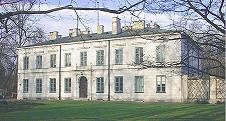Dekoracja malarska na sklepieniu kolegiaty pułtuskiej. Odkrycie, konserwacja, rozwiązanie artystyczno-estetyczne
Painted Decoration on the Vault of the Pułtusk Collegiate Church - Discovery, Conservation, Artistic-aesthetic Solution
Author(s): Stanisław StawickiSubject(s): Fine Arts / Performing Arts
Published by: Krajowy Ośrodek Badań i Dokumentacji Zabytków
Keywords: painted decoration; collegiate church; Pułtusk; preservation; polychrome
Summary/Abstract: The painted decoration embellishing the vault of the collegiate church in Pułtusk is one of the largest in Poland and totals about 700 sq. metres without the frieze (composed of architectural niches), which constitutes the lower part of the vault supported directly by northern and southern abutments. The polychrome was executed after 1551, the year of signing a contract with Master Wojciech of Warsaw. The vault polychrome assumed the form of stylised rosettes, fleurons and portrait - heads, inserted into the architectural-decorative configuration of the vault, which constitutes a net made of the alternate onion-shaped and circular forms, creating the so-called Pułtusk vault. After a fire in 1613, the interior of the church, including the vault, was painted over in a uniform colour, probably imitating the firmament. During the almost 300 years-long history of the church, the vault was frequently painted over in a single hue for aesthetic and hygienic reasons. The same purpose, which was to be realised in 1994, led to the discovery of the polychrome, first mentioned already in the seventeenth century. Routine research preceding the intended painting of the church interior confirmed the existence of polychrome decorations on the vault and, as could be assumed from initial work, also on the frieze. The discovery and ensuing conservation were accompanied by considerable interest on the part of the mass media, especially the press. Numerous widely read journals and popular scientific periodicals quoted characteristic comments and accounts from assorted communiques and newspaper notes. The value of those statements and their editorial form leave much to be desired, although they reflect concern for the historical monument and a readiness to stimulate interest in the fate of national culture. The disclosure and conservation of the painted decoration in Pułtusk constituted a serious effort of conservators of art. Suffice to emphasise that almost 3 cubic metres of six to nin
Journal: Ochrona Zabytków
- Issue Year: 2002
- Issue No: 3-4
- Page Range: 326-338
- Page Count: 13
- Language: Polish

